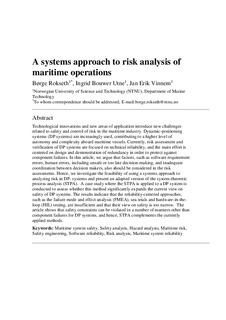| dc.contributor.author | Rokseth, Børge | |
| dc.contributor.author | Utne, Ingrid Bouwer | |
| dc.contributor.author | Vinnem, Jan Erik | |
| dc.date.accessioned | 2017-11-09T07:49:18Z | |
| dc.date.available | 2017-11-09T07:49:18Z | |
| dc.date.created | 2016-12-19T11:59:52Z | |
| dc.date.issued | 2017 | |
| dc.identifier.citation | Proceedings of the Institution of Mechanical Engineers. Part O, Journal of risk and reliability. 2017, 231 (1), 53-68. | nb_NO |
| dc.identifier.issn | 1748-006X | |
| dc.identifier.uri | http://hdl.handle.net/11250/2465075 | |
| dc.description.abstract | Technological innovations and new areas of application introduce new challenges related to safety and control of risk in the maritime industry. Dynamically positioned systems are increasingly used, contributing to a higher level of autonomy and complexity aboard maritime vessels. Currently, risk assessment and verification of dynamically positioned systems are focused on technical reliability, and the main effort is centered on design and demonstration of redundancy in order to protect against component failures. In this article, we argue that factors, such as software-requirement errors, human errors, including unsafe or too late decision-making, and inadequate coordination between decision makers, also should be considered in the risk assessments. Hence, we investigate the feasibility of using a systems approach to analyzing risk in dynamically positioned systems and present an adapted version of the system-theoretic process analysis. A case study where the system-theoretic process analysis is applied to a dynamically positioned system is conducted to assess whether this method significantly expands the current view on safety of dynamically positioned systems. The results indicate that the reliability-centered approaches, such as the failure mode and effect analysis, sea trials, and hardware-in-the-loop testing, are insufficient and that their view on safety is too narrow. This article shows that safety constraints can be violated in a number of manners other than component failures for dynamically positioned systems, and hence, system-theoretic process analysis complements the currently applied methods. | nb_NO |
| dc.language.iso | eng | nb_NO |
| dc.publisher | SAGE Publications | nb_NO |
| dc.title | A systems approach to risk analysis of maritime operations | nb_NO |
| dc.type | Journal article | nb_NO |
| dc.type | Peer reviewed | nb_NO |
| dc.description.version | acceptedVersion | nb_NO |
| dc.source.pagenumber | 53-68 | nb_NO |
| dc.source.volume | 231 | nb_NO |
| dc.source.journal | Proceedings of the Institution of Mechanical Engineers. Part O, Journal of risk and reliability | nb_NO |
| dc.source.issue | 1 | nb_NO |
| dc.identifier.doi | 10.1177/1748006X16682606 | |
| dc.identifier.cristin | 1414972 | |
| dc.relation.project | Norges forskningsråd: 210670/070 | nb_NO |
| dc.relation.project | Norges forskningsråd: 223254 | nb_NO |
| dc.description.localcode | © 2016. This is the authors’ accepted and refereed manuscript to the article. LOCKED until 21.12.2017 due to copyright restrictions. Reprinted by permission of SAGE Publications. | nb_NO |
| cristin.unitcode | 194,64,20,0 | |
| cristin.unitname | Institutt for marin teknikk | |
| cristin.ispublished | true | |
| cristin.fulltext | original | |
| cristin.fulltext | postprint | |
| cristin.qualitycode | 1 | |
